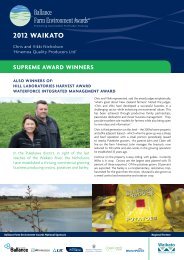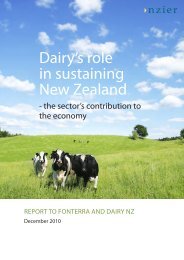NZIER report on compensation for transmission infrastructure
NZIER report on compensation for transmission infrastructure
NZIER report on compensation for transmission infrastructure
Create successful ePaper yourself
Turn your PDF publications into a flip-book with our unique Google optimized e-Paper software.
lump-sum and annual payments (PSC 2009). In Australia and Finland compensati<strong>on</strong><br />
is in a single lump-sum capital payment <strong>on</strong>ly (Harris<strong>on</strong> 2002; Nuuja and Viitanen<br />
2007; Cright<strong>on</strong> 2009).<br />
When compensati<strong>on</strong> was paid annually it was also periodically reviewed. Hydro-<br />
Québec annual payments are reviewed every five years, with payment values and<br />
adjustments based <strong>on</strong> land use. Landowners had the opti<strong>on</strong> of changing from annual<br />
rents to a lump sum payment at these reviews. Annuities were transferrable when<br />
ownership of the land changed (Hydro-Québec 2000). Annual payments in Alberta<br />
were also able to be reviewed every five years (Alanta SRB 2009). Compensati<strong>on</strong><br />
amounts are also re-evaluated periodically in the United Kingdom (NFU 2009).<br />
It was standard practice <strong>for</strong> compensati<strong>on</strong> to be paid annually in the United Kingdom.<br />
The United Kingdom is somewhat unique in that <strong>infrastructure</strong> rights are more often<br />
in the <strong>for</strong>m of a wayleave rather than an easement (see, <strong>for</strong> example, Hamer and<br />
O‟Brien 2007). Wayleaves are pers<strong>on</strong>al to the parties and so do not run with the land,<br />
although, as summarised by Hutchis<strong>on</strong> and Rowan-Robins<strong>on</strong> (2000) “it is not clear<br />
that in effect there is much difference between the two” (wayleaves and<br />
easements). 16 One of the c<strong>on</strong>sequences of wayleaves, however, is that<br />
compensati<strong>on</strong> is generally provided in annual rents rather than lump-sum payments<br />
(Hutchis<strong>on</strong> and Rowan-Robins<strong>on</strong> 2000).<br />
Some authors argued that annual payments provide an advantage to landowners, as<br />
compensati<strong>on</strong> amounts can be periodically adjusted to allow <strong>for</strong> changes in land<br />
values (Beesley 2008; Hutchis<strong>on</strong> et al 1998). If an easement‟s land value is<br />
accurately estimated, however, and an appropriate discount rate used, then there<br />
should be no difference, to the landowner or the utility, between a lump-sum capital<br />
payments and amortised periodic payments. Preference <strong>for</strong> <strong>on</strong>e over the other may<br />
reflect time preferences (whether some<strong>on</strong>e prefers m<strong>on</strong>ey in the hand now or an<br />
income <strong>for</strong> a period of time).<br />
Empirical evidence suggests that many landowners prefer lump-sum compensati<strong>on</strong><br />
<strong>for</strong> easements. The United Kingdom‟s NFU points out that wayleaves are often<br />
c<strong>on</strong>verted to easements under agreement of both landowners and utilities.<br />
Compensati<strong>on</strong> <strong>for</strong> easements is generally assessed at 20 times the annual wayleave<br />
payment (NFU 2009). Based <strong>on</strong> anecdotal evidence it appears that many New<br />
Zealand rural land owners also prefer lump-sum capital payments <strong>for</strong> wind-farm<br />
<strong>infrastructure</strong>, although these are <strong>for</strong> finite access periods (up to 35 years).<br />
Preference <strong>for</strong> <strong>on</strong>e type of payment over another may also reflect differences in<br />
willingness to bear risk. By paying compensati<strong>on</strong> in a lump-sum the utility is certain of<br />
the total cost of that easement. Periodic payments introduce an element of risk that<br />
prices will change by more (or less) than anticipated at the time the easement is<br />
c<strong>on</strong>structed. Lump-sum payments shift this risk to the landowner.<br />
16 N.E. Hutchis<strong>on</strong> and J. Rowan-Robins<strong>on</strong> 2000 page 6.<br />
<str<strong>on</strong>g>NZIER</str<strong>on</strong>g> – Compensati<strong>on</strong> <strong>for</strong> transmissi<strong>on</strong> <strong>infrastructure</strong> 24
















